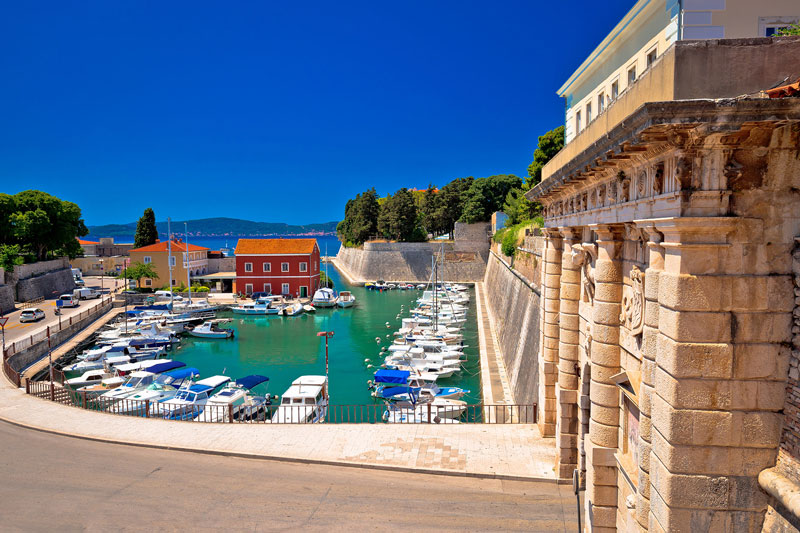The major city of Zadar in northern Dalmatia is built on a peninsula, still partly enclosed by its medieval walls. At the heart of it all is the old Roman forum, the stone from which was used to build St Donat’s Church, a 9th century Byzantine round church dedicated to an Irish bishop.
Some 12miles north of Zadar, the island village of Nin was once Croatia’s ecclesiastical capital and it contains one of the country’s greatest treasures, the tiny, whitewashed 9th century chapel known as the Cathedral of the Holy Cross. Dugi Otok is a long narrow island with several attractive and sheltered anchorages along its shores.
The island has a few hotels, holiday cottages, and a campsite, but it has not been spoilt by tourism. The Kornati Islands, an archipelago of more than 100 rocky islands off the north Dalmatian coast is a paradise for sailors, with calm seas, crystal-clear waters and a remote, ethereal beauty. The Irish playwright George Bernard Shaw wrote that when the gods wanted to crown their work, on the last day they created Kornati ‘from their tears, the stars and their breath’.
Itinerary – Zadar, Dugi Otok & Konati Islands

Day 1 – Zadar
The Zadar region is one of Croatia's 21 Counties, located in the Eastern Adriatic where natural and cultural heritage coexists in perfect harmony and lovely coastal resorts provide excellent conditions for both active and relaxed holidays. The 3000-year-old city of Zadar is a proud city of rich and interesting tradition and amazing cultural heritage, which together with other coastal towns like Biograd and Nin show how the area was important for Croatian Kings and the Roman, Venetian, Turk, Hungarian and Austrian empires.
Day 2 – Iž Veli
The beauty of the island is known only to a few adventurers and sailors, lovers of pure and untouched nature, who just want to escape and enjoy solitude. With no mass tourism you will only find something that only small hidden islands have – tranquility and local residents’ hospitality. Delicious homemade food is guaranteed in restaurants with fishing and agriculture being the traditional occupation of locals. Iž Veli is one of two villages on the island being a quiet place with well-proportioned architecture, many in the Romanesque style.


Day 3 – Sali
Dugi Otok is the meeting of man, nature and historical monuments - the puddles on the island are surprising for the water gathers in such a way like an antique theatre, and every village has some. Do not be surprised if you come upon remains from the paleolithic, Illiryan and Roman periods and while looking through ancient olive groves the remains of churches from the Middle Ages. Sali is the largest and a very attractive village, rich in cultural tradition. The resorts and the closeness of Kornati and the Telašæica national park make it an exquisite Mediterranean spot where idleness becomes an enjoyment.
Day 4 – Vrulje
The Kornati Islands is an archipelago of some 130 islands, islets and reefs, the largest of which is Kornat from where the group takes its name. Their unique feature lies in the rugged shores, caves and coves. The chalk limestone landscape is covered with rosemary, juniper, lavender, thyme, myrtle and sage bushes. With no natural spring water (rainwater being collected in water holes), there are no permanent inhabitants. The largest village on Kornat is Vrulje where you can wander its streets and visit cafes or local restaurants. There are many shoreline restaurants serving a variety of seafood around the archipelago.


Day 5 – Piskera
According to legend: “On the last day of Creation God desired to crown His work and thus created Kornati Islands out of tears, stars and breath” and threw the remaining white rocks into the sea. Enchanted with His creation, he concluded that nothing should be changed. Famous for their uniqueness and beauty, the Kornati Islands become a temporary home for fishermen and farmers in the warmer months of the year and are the perfect destination for those fond of holidaying in complete silence and tranquility. The marina is situated on Piskera and in a narrow channel with neighbouring island Panitula Vela. There are two restaurants nearby and a grocery store within the marina.
Day 6 – Žut
Every bay is a port is the general rule on the island of Žut and in almost everyone you will find a good tavern with excellent homemade cuisine and wine – with the north-eastern shore mostly strewn with tiny, picturesque villages. From the marina climb the beaten path to the nearby peak of Tvrdomešnjak with its fantastic vantage point to the west – particularly at sunrise, sunset and the moonlight.

